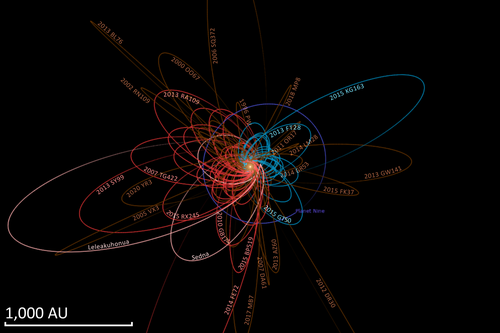2005 VX3
| Discovery Perihelion | 4.1058 AU | |
|---|---|---|
| 914.86 AU | ||
| Eccentricity | 0.9955 | |
| 27,672 yr | ||
| 0.1730° | ||
| 0° 0m 0s / day | ||
| Inclination | 112.22° | |
| 255.35° | ||
| 196.37° | ||
| Jupiter MOID | 0.8884 AU | |
| TJupiter | −0.9430 | |
| Physical characteristics | ||
Mean diameter | 7 km (est.)[4] | |
| 0.09 (assumed)[4] | ||
| 14.1[1][3] | ||
2005 VX3 is
eccentricity of any known minor planet
.
Description
2005 VX3 orbits the Sun at a distance of 4.1–1,826
retrograde orbit and its low Tisserand parameter (TJupiter of −0.9430).[3] It is a Jupiter-, Saturn-, Uranus-, and Neptune-crosser. The body's observation arc begins with its first observation by the Mount Lemmon Survey on 1 November 2005.[1]
| Orbital evolution — Barycentric elements | |||
| Year[7] (epoch) |
Aphelion | Semimajor-axis | Ref |
|---|---|---|---|
| 1950 | 2710 AU | n.a. | [a] |
| 2012 | 1914 AU | n.a. | [b] |
| 2015 | 2563 AU | n.a. | [c] |
| 2016 | 3235 AU | n.a. | [d] |
| 2050 | 2049 AU | 1026 AU | [a] |
2005 VX3 has a
2012 DR30 have a larger barycentric semi-major axis. The epoch
of January 2016 was when 2005 VX3 had its largest heliocentric semi-major axis.
The object has a short
dormant comet that has not been seen outgassing. In the past it may have made closer approaches to the Sun that could have removed most near-surface volatiles. The current orbit crosses the ecliptic just inside Jupiter's orbit and has a Jupiter-MOID of 0.8 AU.[3]
In 2017, it had an
opposition
in mid-June. It would require one of the largest telescopes in the world for any more follow-up observations.
Comparison

See also
Notes
- ^ barycentric coordinates are more stable than heliocentric coordinates.[8] Using JPL Horizons, the barycentric semi-major axis is approximately 1026 AU.[7]
- ^ a b Archived JPL Small-Body Database Browser: (2005 VX3) from 13 December 2012. JPL Epoch 2012 orbital solution that has aphelion (Q)=1914 AU.
- ^ a b Archived MPC object data for (2005 VX3) from Minor Planet Center archive of Epoch 2015-06-27 with aphelion (Q) of 2563 AU.
- ^ a b Archived MPC object data for (2005 VX3) from JPL Webcite archive of Epoch 2016-Jan-13 with aphelion (Q) of 3235AU.
- ^ Archived MPC object data for (2005 VX3) from 8 March 2014.
References
- ^ a b c d "2005 VX3". Minor Planet Center. Retrieved 20 November 2018.
- IAU Minor Planet Center. 8 November 2005. Retrieved 20 November 2018. (K05V03X)
- ^ a b c d e f g "JPL Small-Body Database Browser: (2005 VX3)" (2006-01-21 last obs.). Jet Propulsion Laboratory. Retrieved 20 November 2018.
- ^ a b c d Johnston, Wm. Robert (7 October 2018). "List of Known Trans-Neptunian Objects". Johnston's Archive. Retrieved 19 November 2018.
- ^ "List Of Other Unusual Objects". Minor Planet Center. 14 November 2018. Retrieved 19 November 2018.
- JPL Solar System Dynamics. Retrieved 6 March 2014. (Epoch defined at will change every 6 months or so)
- ^ barycentric coordinates. Select Ephemeris Type:Elements and Center:@0)
- S2CID 16987581.
